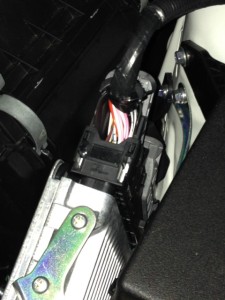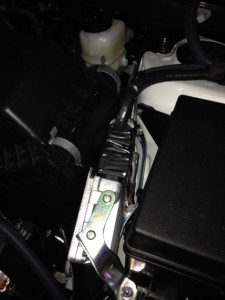Here’s a post from the “I wish I’d noticed this before I bought the car” file.
Under the hood on the driver’s side of my new 2013 Toyota RAV4 is one of the car’s computers, or engine control modules (ECM). It’s mounted on a bracket at an odd angle next to one of the relay boxes. Mine is labeled “Denso Engine Control” and is made in Japan. Encased in an a elements-resisting metallic case, you can’t miss it (although I did when I was shopping for the car). On the back (firewall side) of the ECM are two serious-looking (that is, large) electrical connectors that I assume deliver sensor input and transport engine control commands to the rest of the digital controls in the car.
Obviously this is a pretty important component, wouldn’t you agree? And it needs to be protected from the elements, especially the kinds of things that create electrical gremlins in circuitry — moisture, grime and exposure. Take a look at this photo, shot looking down into the top of the ECM with the hood open. The wiring from the bus connector is completely exposed. Any schnizz from the road that gets into the engine compartment is going to go directly into this connector.

So the question is, how could Toyota design, engineer and build for customer delivery a connector that exposes the top of the wiring harness of a digital computer to the elements? The answer is obvious: it was done cheaply. A few cents of electrical tape and a few seconds of assembly time are all that’s needed to protect this crucial component and improve reliability and dependability. Modern Toyotas seem to be built like 1980s GM cars — they could be well-built, but aren’t because of “value engineering” in design and manufacturing. The RAV4 isn’t inexpensive — but now we have to wonder what else was done to make it cheap.
Anyway, you can fix this yourself without getting your hands dirty. Open the hood, apply some black electrical tape to the gaping hole at the top of the ECM connector and you’re done. Here’s a shot of mine after 30 seconds of effort.

Leave a Reply